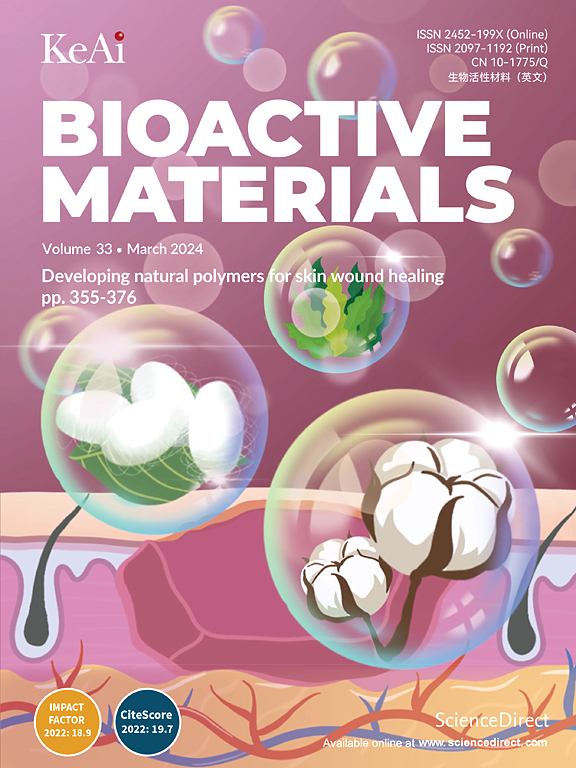单细胞RNA测序引导工程通过调节mtDNA/SPARC-STING信号治疗椎间盘退变的线粒体疗法
IF 18
1区 医学
Q1 ENGINEERING, BIOMEDICAL
引用次数: 0
摘要
椎间盘变性(IVDD)是导致椎间盘源性腰背痛的主要原因,在很大程度上造成了全球残疾和经济负担。目前的治疗方法只能缓解短期疼痛,却无法从根本上解决发病机制。在此,我们报告了以人类髓核组织的单细胞 RNA 序列数据为指导的 IVDD 生物仿生疗法工程,以及使用动物模型进行的验证。深入分析显示,线粒体功能障碍在 IVDD 进展过程中核髓细胞(NPCs)纤维化表型极化中起着关键作用。因此,线粒体移植被认为是一种新的治疗策略。移植的外源线粒体通过内吞、单独分布或与内源线粒体融合,并通过隧道纳米管转移到邻近细胞,改善了病理条件下髓核细胞的线粒体质量控制。相应地,椎间盘内线粒体移植明显延缓了穿刺诱发的大鼠 IVDD 的进展,显示了维持线粒体平衡和缓解病理异常的功效。此外,外源线粒体中还加入了一种具有生物活性的线粒体靶向大分子,以增强抗氧化和抗炎活性。所获得的多种生物活性生物疗法在治疗 IVDD 方面的疗效显著增强,可通过 mtDNA/SPARC-STING 信号通路逆转 IVDD 的进展并恢复结构的完整性。总之,我们的线粒体工程疗法在治疗 IVDD 和其他与线粒体功能障碍有关的肌肉骨骼疾病方面大有可为。本文章由计算机程序翻译,如有差异,请以英文原文为准。

Single-cell RNA sequencing-guided engineering of mitochondrial therapies for intervertebral disc degeneration by regulating mtDNA/SPARC-STING signaling
Intervertebral disc degeneration (IVDD) is a leading cause of discogenic low back pain, contributing significantly to global disability and economic burden. Current treatments provide only short-term pain relief without addressing the underlying pathogenesis. Herein we report engineering of biomimetic therapies for IVDD guided by single-cell RNA-sequencing data from human nucleus pulposus tissues, along with validation using animal models. In-depth analyses revealed the critical role of mitochondrial dysfunction in fibrotic phenotype polarization of nucleus pulposus cells (NPCs) during IVDD progression. Consequently, mitochondrial transplantation was proposed as a novel therapeutic strategy. Transplanted exogeneous mitochondria improved mitochondrial quality control in NPCs under pathological conditions, following endocytosis, separate distribution or fusion with endogenous mitochondria, and transfer to neighboring cells by tunneling nanotubes. Correspondingly, intradiscal mitochondrial transplantation significantly delayed puncture-induced IVDD progression in rats, demonstrating efficacy in maintaining mitochondrial homeostasis and alleviating pathological abnormalities. Furthermore, exogenous mitochondria were engineered with a bioactive, mitochondrial-targeting macromolecule to impart anti-oxidative and anti-inflammatory activities. The obtained multi-bioactive biotherapy exhibited significantly enhanced benefits in IVDD treatment, in terms of reversing IVDD progression and restoring structural integrity through the mtDNA/SPARC-STING signaling pathways. Overall, our engineered mitochondrial therapies hold great promise for treating IVDD and other musculoskeletal diseases linked to mitochondrial dysfunction.
求助全文
通过发布文献求助,成功后即可免费获取论文全文。
去求助
来源期刊

Bioactive Materials
Biochemistry, Genetics and Molecular Biology-Biotechnology
CiteScore
28.00
自引率
6.30%
发文量
436
审稿时长
20 days
期刊介绍:
Bioactive Materials is a peer-reviewed research publication that focuses on advancements in bioactive materials. The journal accepts research papers, reviews, and rapid communications in the field of next-generation biomaterials that interact with cells, tissues, and organs in various living organisms.
The primary goal of Bioactive Materials is to promote the science and engineering of biomaterials that exhibit adaptiveness to the biological environment. These materials are specifically designed to stimulate or direct appropriate cell and tissue responses or regulate interactions with microorganisms.
The journal covers a wide range of bioactive materials, including those that are engineered or designed in terms of their physical form (e.g. particulate, fiber), topology (e.g. porosity, surface roughness), or dimensions (ranging from macro to nano-scales). Contributions are sought from the following categories of bioactive materials:
Bioactive metals and alloys
Bioactive inorganics: ceramics, glasses, and carbon-based materials
Bioactive polymers and gels
Bioactive materials derived from natural sources
Bioactive composites
These materials find applications in human and veterinary medicine, such as implants, tissue engineering scaffolds, cell/drug/gene carriers, as well as imaging and sensing devices.
 求助内容:
求助内容: 应助结果提醒方式:
应助结果提醒方式:


